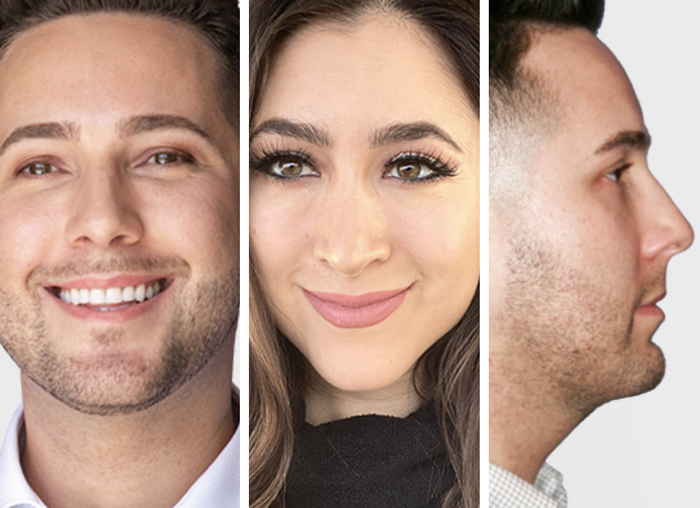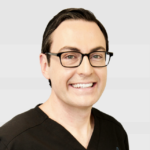Revision rhinoplasty, also known as secondary rhinoplasty, is a very specialized and complex part of plastic surgery. Rhinoplasty (nose reshaping or “nose job” surgery) is frequently considered the most difficult procedure in cosmetic plastic surgery. Revision rhinoplasty improves upon inferior or unsatisfactory results and/or corrects complications from the primary surgery. When performing revision rhinoplasty, Dr. Ransom believes it is essential to address not only the aesthetic issues (the way the nose looks), but also the functional issues of breathing problems (such as deviated septum, septal spurs, nasal obstruction from enlarged turbinates, internal or external nasal valve collapse, nasal valve stenosis, or nostril stenosis).
Revision Rhinoplasty Information
Many patients have suffered self-image problems and been traumatized by one or more complications or undesirable rhinoplasty results. He is a revision rhinoplasty specialist, and, with his background and specialty training in Facial Plastic Surgery, Facial Reconstructive Surgery, and nasal surgery, is uniquely qualified to help patients with aesthetic or functional issues from prior nasal surgery. Dr. Ransom recognizes the mental and emotional concerns of patients seeking revision rhinoplasty and works closely with them through this difficult process.
Explore our
Patient Gallery
*Actual patients in photos

Revision rhinoplasty frequently requires a nose to be reduced in size, either the entire nose or a specific part that was not adequately treated in the primary procedure. Common problems include a nasal hump being partially or completely left behind (bump on the bridge, sometimes called a “Polly beak” deformity because it results in the nose looking like a parrot’s beak in profile), a tip that remains too wide (“bulbous tip” or “boxy tip”) or lacks definition, a tip that is still droopy (tip ptosis), or nostrils that are too large or too widely spread apart (nostril or alar flare). Given that the problems encountered in revision rhinoplasty are different for each patient, the surgery must be customized for each patient’s unique anatomy and function.
The specific maneuvers necessary may be as simple as removing excess cartilage or bone on the bridge, or as complex as straightening a crooked nose or reshaping the cartilages and nostrils. Some common techniques include cephalic trim, dome sutures, flare sutures, overlay procedures, alar base reduction, and osteotomies.
In more rare cases, the nose has been made too small (“over-resected”), either in certain parts or the entire nose. In such cases, the nose must be restructured by adding cartilage support and placing grafts. If too much cartilage is removed in a revision rhinoplasty, it is possible that the nose will collapse (“saddle nose”). Performing cartilage grafting is essential, to support the nose structurally, to maintain or improve breathing, and also to avoid an unnatural “pinched tip”, upturned or “pig nose”, or a collapsed middle part of the bridge called an “inverted V” deformity because the contour looks like an upside-down letter “V”. Some techniques that are used in these cases include caudal septal extension grafts, batten grafts, spreader grafts, columellar or lateral crural strut grafts, tip grafts, or plumping grafts. Whenever possible, Dr. Ransom prefers to use the patient’s own tissue for nasal reconstruction or revision rhinoplasty. Materials commonly used include the septal cartilage, ear cartilage (from the “bowl” of the ear), or even rib cartilage in extreme cases or with multiple revisions. Dr. Ransom would be happy to discuss revision rhinoplasty in detail during your confidential consultation.
Download Our Revision Rhinoplasty Guide
Click below to download all of the information provided on our website in a PDF.
Who is a candidate?
Anyone who has had a previous rhinoplasty (nose reshaping) and was not satisfied by either the appearance of the nose or the nasal function (breathing, smell, etc.). In most cases, revision rhinoplasty is performed using an open technique; this is especially true for patients with a crooked nose, a history of nasal trauma (for example, an untreated fracture), or significant functional concerns (breathing problems). Some surgeons use synthetic materials or implants during rhinoplasty surgery.
These materials, unfortunately, have a relatively high rate of complications – including infection, weakening of the underlying bony or cartilaginous structure of the nose, or even extrusion (meaning that the material breaks through the skin, either on the outside of the nose or into the nasal passages). In patients with synthetics or implants, it is often necessary to remove these materials during the revision rhinoplasty. Dr. Ransom can then replace them with your own tissues, by using grafts from other parts of the body. If the implanted materials have become infected or are extruding, you may require a course of antibiotics prior to revision surgery. This is essential to guarantee the best possible result, both functionally and aesthetically.
Frequently Asked Questions
Please note that all patients are different and individual healing times and results may vary. The statements regarding procedures and recovery made here are general rules.
In most cases, you will have a cast on the nose for about a week after the procedure. This helps to protect the nose from accidental trauma, and also stabilizes the bones during the initial healing phase. No packing is used in the nose, which makes recovery much more comfortable. Your nose may feel “stuffy” for a few days, but this resolves quickly. Pain is minimal. You will likely feel tired for a couple days and should limit your activities and concentrate on resting and recovery. Contact sports, racket and ball sports, heavy lifting, and straining must be avoided until Dr. Ransom gives you the “okay” – this is typically a couple weeks. You will also be given clear instructions regarding blowing your nose, sneezing, and digital manipulation; in general, these are to be minimized as much as possible or avoided completely.
For most patients, the initial recovery is relatively quick – typically a week. Due to swelling inside the nose, many patients feel “stuffed up” for a few days. Bruising is limited, though some swelling will occur throughout the nose. Much of this resolves over the first week, but some swelling will persist after that and will take longer to go away completely. Pain is minimal and Dr. Ransom does not use nasal packing, making recovery more comfortable for his patients. Most plastic surgeons agree that the final result of a rhinoplasty is not seen for at least six months, and it is common to see subtle changes up to a year from the surgery. This is especially true in revision rhinoplasty, where there is more healing time needed.
During the healing phase after your procedure, there will be swelling inside the nose. This takes some time to resolve, and may cause a temporary sensation of blockage or “stuffy” nose. After the swelling resolves, there should not be any changes to your breathing. In fact, Dr. Ransom is a nose specialist and uses this knowledge to make sure that his patients’ breathing is not negatively affected by nose reshaping. In some cases where the septum is crooked or functional issues (difficult nasal breathing) exist before surgery, Dr. Ransom can actually improve the breathing during your rhinoplasty. Any issues pertaining to breathing can be discussed during your confidential consultation.
Dr. Evan Ransom is an Ivy League-educated and Ivy League trained Facial Plastic and Reconstructive Surgeon. He is a Double Board Certified Head and Neck Surgeon and Facial Plastic and Reconstructive Surgery and fellowship-trained in facial plastic, reconstructive, and laser surgery. His practice is in the San Francisco Bay Area, serving patients from San Francisco, Oakland, Marin County, Palo Alto, Silicon Valley, Walnut Creek, the East Bay, and all over Northern California.
 (415) 550-1077
(415) 550-1077 San Francisco
San Francisco

 Play Video
Play Video



